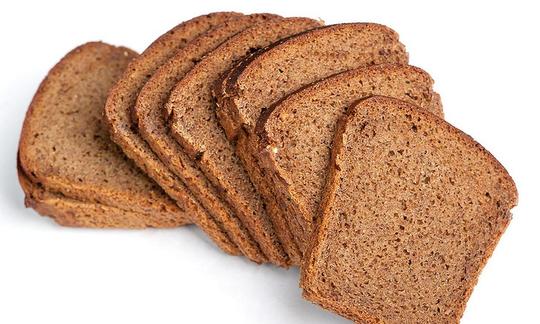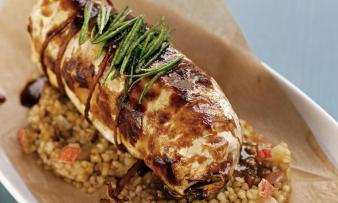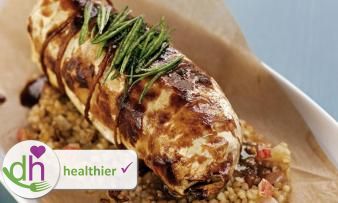Table of contents
Toast is very popular, whether hot or cold, especially in western countries. Loaf bread is made from spelt flour. Ideally in organic quality, it is used for snacks, starters, sandwiches or other dishes. As a vegan version, it does not contain any animal products such as milk.
Use in the kitchen
Toast bread is pre-cut, fine-pored loaf of bread with a thin crust that is preferably toasted before consumption. It is usually made from flour ( wheat flour or spelt flour), water, salt, sweetener (e.g. sugar) and a raising agent (e.g.baker's yeast). Depending on the type, it may contain milk or milk powder and is therefore not always vegan. There are various types available on the market that differ in their composition: butter toast, multigrain toast, wholemeal toast, sandwich toast. Used primarily in British cuisine, toast bread is now consumed all over the world. Whether for sweet or salty, light or hearty dishes, toast bread is versatile. Dark wholemeal bread in slices is also increasingly available to buy.
Toast can be refined with various vegan spreads, such as a mustard and pumpkin spread, a rocket pesto, or a chickpea hummus or eggplant hummus. Toast with avocado and herbs is also popular. Classics include Hawaiian toast, toast topped with pineapple and baked with cheese - or Melba toast with peaches. The slices of toast are also used to make canapés, bite-sized starters or appetizers with different spreads or toppings.
Many desserts can be made with toast. Well-known examples are "poor knights" and "French toast". For the vegan version, you use plant-based milk (e.g. almond milk, soy milk) and an egg substitute (e.g. aquafaba or okara). Combinations such as plant-based drink and corn starch, chickpea flour or rice flour are also possible. Here you use 1 tablespoon of starch or flour for every 50 ml of plant-based drink. Alternatively, you can mix a mashed banana into the plant-based milk. Simple sweet snacks can be made with toast and jam, date syrup or honey. Peanut butter or almond paste is sometimes used as a spread on toast.
Toast is often toasted before consumption, which changes the taste and consistency of the toast. The popular roasted aroma is created by the so-called Maillard reaction, in which amino acids and reducing sugars are converted into new compounds at high heat. Roasted, baked or burnt protein-rich foods therefore have a more intense flavor. However, this also creates undesirable substances such as acrylamide, which has potentially mutagenic and carcinogenic compounds.
Since its nutritional value is considered to be low, toast should only be consumed occasionally. Combining it with healthy foods such as vegetables, fruit and herbs 'increases' the nutritional value of a toast sandwich or toasted sandwich. Instead of toast for breakfast, it is better to eat pea muesli, which contains valuable ingredients and keeps you full for longer.
Homemade toast
Since toast bread from the supermarket often contains additives and emulsifiers, it may be advisable to make the bread yourself.
Ingredients (for 500 g toast bread): 500 g flour (e.g. spelt flour), 1 teaspoon salt, 1 tablespoon sugar, 1 packetof dry yeast, 150 ml oat milk (lukewarm), 150 ml water (lukewarm), 40 g vegetable margarine.
Preparation: Dissolve yeast in lukewarm oat milk. Put flour, salt, sugar and vegan margarine in a bowl and mix. Add yeast-milk mixture and knead everything into a smooth dough. Cover and let dough rise in a warm place for about 1 hour. After the rising time, roll out the dough into a rectangle on a floured surface. Cut the rectangle into 12 equal-sized pieces. Shape the pieces of dough into small rolls and place in a greased loaf pan. Cover and let the bread rise for another 30 minutes. Preheat the oven to 180 °C top/bottom heat. Bake the bread in the preheated oven for about 40 minutes. Remove the bread from the oven and let it cool on a wire rack.
Vegan recipe for raw vegetable salad with toast croutons
Ingredients (for 4 people): 1 largehead of lettuce, 1 cucumber, 1 sweet pepper (red), 1 tomato, 1 onion, 1 radish, 4 slices of vegan toast (organic), 2 tbsp rapeseed oil (cold-pressed), 1 tbsp lemon juice, salt,pepper.
Preparation: Wash the lettuce and cut into small pieces. Wash the cucumber, sweet pepper and tomato and cut into small cubes. Finely chop the onion. Wash the radishes and cut into slices. In a small bowl, mix the rapeseed oil, lemon juice, salt and pepper to make a dressing. Mix all the ingredients in a large bowl and drizzle with the dressing. Divide the salad between four plates. Toast the bread, cut into small cubes and spread evenly over the salad. Serve the vegan raw vegetable salad immediately.
Vegan recipes with toast bread made from spelt flour can be found under the note: " Recipes that have the most of this ingredient ".
| Not only vegans or vegetarians should read this: Vegans often eat unhealthily. Avoidable nutritional errors. |
Purchasing - Storage
Major retailers such as Coop, Migros, Denner, Volg, Spar, Aldi, Lidl, Rewe, Edeka, Hofer and Billa have toast bread (light and dark) in their range, some of which are organic. Organic supermarkets such as Denn's Biomarkt and Alnatura offer organically certified spelt toast bread (including wholemeal).
Wholemeal toast (eg made from spelt flour) is preferable to buttered toast (light wheat toast) from a nutritional point of view. However, you should not rely on the color when buying toast, as this depends on the sugar content and other color-changing ingredients. The list of ingredients shows whether the toast is made from wholemeal flour. Toast often contains emulsifiers and stabilizers.
The availability of spelt toast varies depending on the size of the store, catchment area, etc. Our recordedfood prices for the DA-CH countries can be found above under the ingredient image - and by clicking on them you can see their development at various suppliers.
Storage tips
Toast or dark bread should be stored away from moisture, otherwise it will mold. It is best to store toast in a bread box and not in the plastic bag that you often buy it in. This will extend the shelf life of the toast for several days.
Alternatively, you can freeze the slices in a freezer bag in the freezer compartment of the refrigerator and defrost them again in a toaster when needed. They can be kept fresh for several weeks when frozen.
Check for possible mold before consumption.
Ingredients - Nutritional values - Calories
100 g of toast made from spelt flour provides 276 kcal of energy and has 4.3 g of fat, 52 g of carbohydrates and 10 g of protein. It is worth mentioning the amount of table salt (sodium chloride) it contains, which is 1219 mg/100g. 1
Because toast bread contains a lot of table salt, it also has a high sodium content. This amounts to 480 mg per 100 g of toast, which is 60% of the daily requirement. In contrast, vegan rusks have less sodium (263 mg/100g). 1
The manganese content is relatively high at 1.3 mg/100g and accounts for 65% of the daily requirement. Buckwheat and tempeh show similar values and wheat germ has ten times as much at 13 mg/100g.
Folate is present in 84 µg/100g, almost as much as in millet or rice flakes. Yeast extract has impressive values of 3786 µg/100g, although people tend to take very little of it.
You can find all the ingredients of spelt toast, the coverage of the daily requirement and comparison values with other ingredients in our nutrient tables. In the article Nutrients explained you will get a detailed insight into the topic.
Effects on health
Is toast healthy? Is wholemeal toast healthy? Toast is usually an industrially manufactured ready-made product that, depending on the manufacturer, contains large amounts of sugar and salt, as well as preservatives and flavor enhancers, which are not good for your health. It also contains very few vitamins and minerals.
Is toast good for losing weight? Can I lose weight with toast? Is toast better than bread? A study shows that toasted bread leads to a lower blood sugar reaction than white bread. It has a lower glycemic index (GI). 11 Based on this study, you sometimes read the suggestion that toast is better for losing weight than bread. However, a slice of toast contains 70-120 kcal and does not keep you full for long. Rusks are also recommended as a snack for losing weight. A piece of rusk (approx. 10 g) contains around 38 kcal. Vegetables and fruit are healthier alternatives that help you lose weight. A large carrot has about the same number of calories (100 g = 41 kcal) but keeps you full for longer than a single rusk or slice of toast. You can find more information on the subject of weight loss in our article " Lose weight healthily and permanently ".
From a nutritional point of view, toast - even wholemeal toast - has little value. You should therefore only eat toast occasionally.
Dangers - Intolerances - Side effects
Toast, which is usually made from wheat flour, is not digestible for everyone. It contains gluten, which is why people with gluten intolerance or celiac disease cannot eat it. You can also sometimes find gluten-free toast in stores.
The browning during toasting is caused by a non-enzymatic browning reaction called the Maillard reaction. The amino acids (components of proteins) react with the sugar, which leads to browning and the formation of new compounds (so-called melanoidins). The new compounds are partly responsible for the taste. However, several potentially mutagenic and carcinogenic compounds can also be formed, such as acrylamide. 2
Acrylamide intake should be as low as possible to protect health. This can be minimized by using less sugar and lower temperatures during production. A test of Austrian foodstuffs (2007-2015) found a content of 46 µg/1kg for bread. Zwieback has a much higher content of 250 µg/1kg due to the re-baking process, which is why it can be assumed that toast also has a higher acrylamide content than bread. 3
Ecological footprint - animal welfare
The CO2 footprint is primarily used to assess the climate friendliness of a food. This depends on various aspects, such as cultivation method (conventional/organic), seasonality, country of origin, processing, transport and, if applicable, packaging.
The carbon footprint of wheat bread used to make toast is 0.94 kg CO 2 eq/kg, according to The Big Climate Database. 5 In contrast, Carboncloud gives a value of 5.43 kg CO 2 eq/kg. 5 In 2019, the Institute for Energy and Environmental Research Heidelberg (IFEU) examined almost 200 foods in Germany for their environmental impact. The value for bread is 0.6 kg CO 2 eq/kg and for pastries it is 1.6 kg CO 2 eq/kg. 6
Wheat bread has a global average water footprint of 1608 l/kg, and cherries use a similar amount of water. Average vegetables, however, only need a fraction of this amount of water (322 l/kg). Potatoes, for example, which are also carbohydrate-rich foods, have a water footprint of just 287 l/kg. 7
For detailed explanations of various sustainability indicators (such as ecological footprint, CO2 footprint, water footprint), see our article: What does the ecological footprint mean?
Worldwide occurrence - cultivation
Toasted bread has been used for centuries as a way to make bread last longer by removing water. Zwieback is known for its long shelf life and is made specifically to be stored for as long as possible.
Toast bread in its current form as a loaf of bread, which can be bought already sliced and baked in a toaster, comes from British and American cuisine. The electric toaster was invented as early as the 1890s. The first 'pop-up toaster' was invented by the American Charles Strite in 1921. This also had a timer, so that you no longer had to monitor the toasting as with the older models. Restaurants and private households bought the toaster and the popularity of toast bread rose quickly. 4
Industrial production
Commercially produced toast bread is baked in loaf pans so that it retains its typical shape. The ingredients are mixed in a large container, then a mechanical spiral dough kneader works the dough until it has reached the desired elasticity and consistency. It is then filled into baking trays and left to rest briefly in the proving cabinet until the dough has risen to the desired volume. As soon as this is achieved, the baking tray is closed with a lid and placed in the oven. Baking usually takes place in a belt oven at different temperatures (240–280 °C). 8 Other sources give a baking temperature of 190–220 °C. 9 It is important that the toast bread remains light and that no thick crust can form.
After baking, the toast bread is removed from the baking tray and left to cool for several hours. A cutting machine cuts the bread into equally thin slices. The bread is then packaged by sealing the sliced toast bread in plastic film. 8
Product research shows that production using steam baking is also possible. These breads contain particularly little harmful acrylamide. Steam is fed into the oven, which reduces the temperature of the crust and thus leads to less acrylamide formation. 10 We were unable to determine how many manufacturers already use steam ovens.
Further information
Industrially produced toast is pre-cut and all manufacturers produce slices of roughly the same size so that they fit into standard toasters with similarly sized toasting slots. There are also increasingly larger slices of toast that are marketed as American toast. This variant is usually used untoasted as a sandwich base or spread with jam or peanut butter.
Alternative names
Toast bread is called toast or roasted bread. The English name is toast bread.
Bibliography - 11 Sources
| 1. | ÖNWT Österreichische Nährwertdatenbank. Dinkel Toast (ÖNWT2.0 B201C00). |
| 2. | ALjahdali N, Carbonero F. Impact of Maillard reaction products on nutrition and health: Current knowledge and need to understand their fate in the human digestive system. Crit Rev Food Sci Nutr. 2019;59(3):474-487. |
| 3. | AGES Österreichische Agentur für Gesundheit und Ernährungssicherheit GmbH. Rückstände und Kontaminanten von A bis Z. Acrylamid. |
| 4. | Hennepin History Museum. Thiede A. The Demise of Burnt Toast: The Invention of the Pop-up Toaster. 2018. |
| 5. | Concito. The Big Climate Database. Wheat bread, for toasting, industrially produced. 2024. |
| 6. | Carbon Cloud. Toast, ost, vegetarisk, 24x 128 g. |
| 7. | Mekonnen MM, Hoekstra AY. The green, blue and grey water footprint of crops and derived crop products. Hydrol Earth Syst Sci. 2011;15(5):1577–1600. |
| 8. | Schweizerbrot. Keck M. Glück im Quadrat. 2022. |
| 9. | Clean-ingredients. Toastbrot - Wissenswertes zur Herstellung von Toastbroten. |
| 10. | Ahrné L, Andersson CG, Floberg P, Rosén J, Lingnert H. Effect of crust temperature and water content on acrylamide formation during baking of white bread: Steam and falling temperature baking. LWT-Food Sci Technol. 2007;40(10):1708–1715. |
| 11. | Burton P, Lightowler HJ. The impact of freezing and toasting on the glycaemic response of white bread. Eur J Clin Nutr. 2008;62(5):594-599. |










Comments